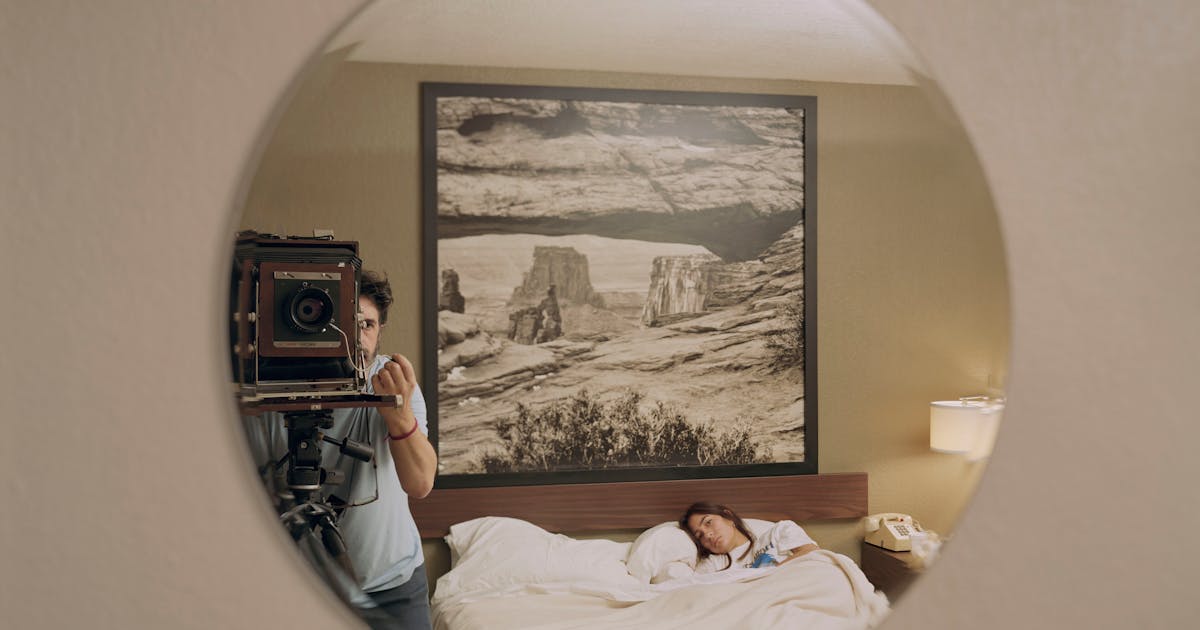[ad_1]
It was 2018, and photographer Alec Soth felt charged, ready to respond to the political divisions that were changing America.
It would follow the path of the Abraham Lincoln funeral train, which carried the slain president’s body from Washington, DC, to Springfield, Illinois, after the Civil War. But after two trips, the project felt forced, and he backed off. A false start.
He tried again like some kind of rambling diary, but the pandemic hit. On the third attempt, he landed on a new project, buying old photos as he traveled across the country and letting them pave the way for new ones.
The project is summarized in a photobook coming in February and an exhibition opening Friday at the Weinstein Hammons Gallery in Minneapolis in conjunction with exhibitions in New York and San Francisco.
“A Pound of Pictures” is best described as a photo project about photography. Each image of Soth contains a surprising and thoughtful story, whether it’s a photo of a portrait of Buddhist teacher Pema Chödrön and a bottle of pills parked on a dashboard, or a bed of motel covered in pictures of young women (not a serial killer reference).
During this journey of collecting photographs from amateurs while taking his own, Soth found himself. This interview has been edited for clarity.
Q: Why make a photo book on the idea of photography?
A: In poetry, there is a traditional form called “Ars Poetica” which is basically a poem about poetry. I’m also a fan of the book “Understanding Comics: The Invisible Art”, which is a comic about how comics work. I wanted to do something similar with photography. It’s not about the medium in general, but about photography as I see it. It’s about my process, and also some of my creative influences.
During my travels, I met artists like Sophie Calle, Nan Goldin, Duane Michals and Sid Kaplan. There are references to these encounters in the book, but sometimes they’re quite subtle. I only show Goldin’s bed, for example. It’s about my seniors, traveling with youngsters, visiting amateur photographers, thinking about the medium…trying not to squeeze the handlebars too much, thinking a bit about America, but trying to find joy in the flowers and stuff like that too.
Q: How long have you been on the road?
A: I started in 2018. Probably something like a dozen trips of varying lengths. We had these stops and restarts because of the pandemic and the evolution of the project.
Q: Even with photos of people, there is this distance. How come?
A: I think that’s nice of me. The last project I did, I was working in interior spaces with people, but it’s a bit out of the ordinary in my work. Distance is kind of my jam.
Q: Has the pandemic affected this sensitivity?
A: At first it affected everything. And especially photographing – anyone who wasn’t middle-aged white people – was stressing me out. I think there’s this weird mix of intimacy and distance that seems to be a guideline in my work.
There is one exception in this book, my daughter. But usually it’s not people I know. I don’t spend weeks living with them or anything. But there’s a flash of something that hopefully feels intimate, like catching someone’s eyes and staring at them for a minute.
Q: What is the concept behind collecting other people’s photos?
A: Molly, this barista at my local Dogwood Coffee who was studying photography, I asked her if she wanted to take a trip with me. So we started down the Mississippi, my old playground [from his breakthrough project “Sleeping by the Mississippi”].
We were in Winona and stopped at this antique store, and this guy had a box of pictures. I bought him pictures. One of them started guiding me on this journey – it was a photo of a man and his head was photographed from five different sides. Collecting pictures became something I did alongside taking pictures.
At one place I went to in Pennsylvania, a guy had half a million pictures in his house. I spent eight hours browsing photos and bought some more great photos. I realized that is more than I will ever take in my life and they are all superior to anything I will ever do. But of course they have no context, they are not anchored in any way. They float there.
The funny thing about this medium – you can have accidental masterpieces all the time, which is quite different from cinema.
Q: Why did you have this formal, eye-catching project in mind at first if that’s not how you work?
A: It reminds me of, in the year 2000, the Minnesota Historical Society or someone was giving a grant for people to document the state. I was like, “I’m offering to photograph WWII veterans.” I didn’t get that scholarship and I was relieved — it wasn’t me, it was me trying to be a certain kind of photographer. I think something about that period of the Trump era brought out that part of me that wanted to try to be that political anything – statement photographer – and it’s just…it doesn’t is not who I am.
A picture book
When: 12pm-5pm Tue-Sat or by appointment from January 28.
Or: Weinstein Hammons Gallery, 908 W. 46th St., Mpls.
Information: 612-822-1722 or weinsteinhammons.com.
[ad_2]
Source link

